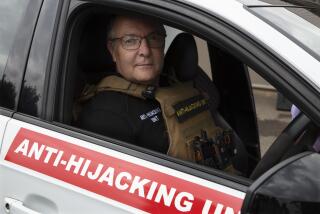Post-Apartheid South Africa Swamped by Crime
PRETORIA, South Africa — The cavernous courtroom was nearly empty, with only four spectators and reporters watching as a DNA expert patiently explained the techniques of his trade.
Even the defendant, 32-year-old Moses Sithole, appeared bored. Smartly dressed in a double-breasted suit, he adjusted his gold-rimmed glasses and read a newspaper as the witness droned on.
So goes the trial of the man accused of being South Africa’s worst known serial killer.
Police have charged Sithole with 38 murders and 40 rapes, all allegedly committed in less than two years. In addition, police say Sithole has confessed to scores of other murders--perhaps 70 in all--that they can’t prove in court.
Sithole’s case probably would draw huge crowds and big headlines anywhere else. But it has been overshadowed here by the daily reminders of grisly violence and mayhem in one of the world’s most crime-ridden societies.
South Africa has the industrialized world’s highest reported rates of murder and rape. The wave of lawlessness, which cuts across economic and racial lines, has terrified residents and frightened tourists and foreign investors since apartheid ended in 1994.
The government has indicated that it is taking the concerns seriously.
The 1997-98 budget, announced last week, includes spending increases of nearly 15% for police, prisons and courts. Last year, their budgets saw only nominal increases.
For the first time, more money will be spent on policing than on national defense. Only the education and housing departments had larger spending increases, and most government bureaus had cuts.
Experts blame the crime wave partly on the culture of violence engendered during the bitter struggle against institutionalized white oppression. But criminal syndicates, drug traffickers and guns have flooded into the country under democratic rule. So have illegal immigrants, adding to the estimated 40% black unemployment.
Crimes such as the theft of an entire automatic teller machine from police headquarters here and the burglary of Safety and Security Minister Sydney Mufamadi’s home by a corrupt policeman, have done little to reassure a nervous public that increasingly lives behind high walls and barred windows.
President Nelson Mandela, among others, has accused the police force of corruption and incompetence.
Last year, according to a new government report, police solved proportionally fewer crimes--fewer than half those reported--than the year before. Even worse, police officers were more than twice as likely as other citizens to be charged with murder.
The report also indicated that the overall crime wave may have peaked. Most serious crime categories appeared to stabilize last year. Reported killings, car hijackings, drug-related offenses and aggravated robberies even fell slightly.
But with 25,782 slayings in a nation of about 42 million people, South Africa’s murder rate remains nearly seven times that of the United States.
And reported rape has gotten worse, surging by 19%, with more than 50,000 complaints filed last year. Even before the rise, South Africa’s rape rate was three times that of the United States. Serious assaults and home break-ins also were up sharply.
Serial murders and rapes are only a small part of the country’s crime crisis. But it is a growing problem. Police have investigated at least eight serial murder cases involving more than 120 deaths in the last three years.
Micki Pistorius, a 36-year-old psychologist, has become the country’s expert on serial killers and rapists since she joined the police in 1994. She assists detectives by compiling profiles of possible killers and helping to interrogate suspects.
South Africa’s serial killers, Pistorius said, are like those elsewhere: They usually choose strangers as targets and typically appear quite normal.
“They go to work, they go to church, they walk their children to school,” she said. “Serial killers are not raving lunatics with foam coming out of their ears.”
That apparently was the case with Sithole, a former choirboy and amateur boxer.
“He had a wife and child,” police Capt. Leon Nel, the investigating officer, said during a break in the trial. “He went home every night. He only killed during the day.”
Police say Sithole terrorized communities between Johannesburg and Pretoria from November 1993 to October 1995, when he was arrested. All the victims were black women, except for a 2-year-old boy who was killed with his mother.
“He’s extremely nice,” Chief Prosecutor Retha Meintjes said. “That’s how he conned all these women to come with him.”
More to Read
Sign up for Essential California
The most important California stories and recommendations in your inbox every morning.
You may occasionally receive promotional content from the Los Angeles Times.











